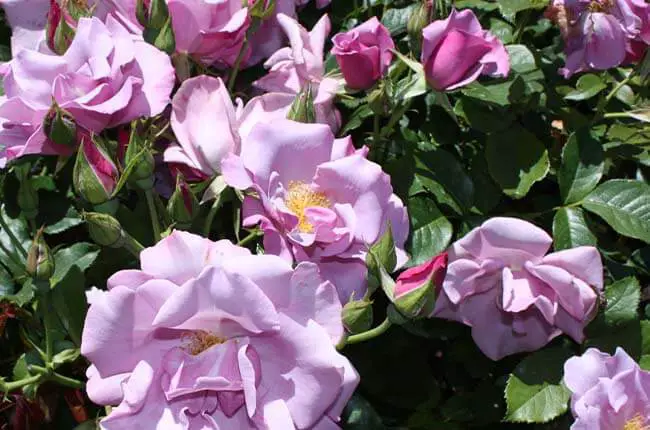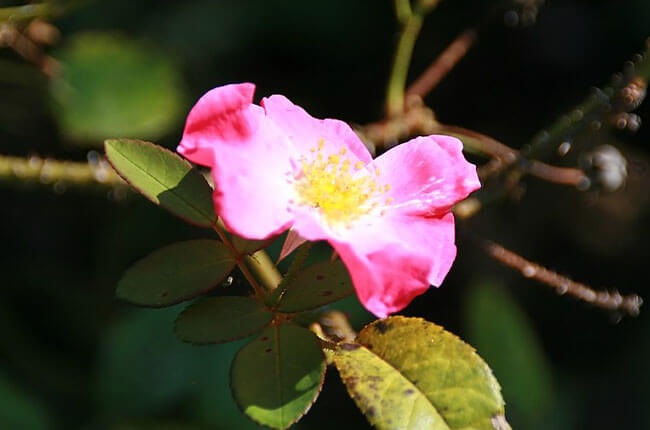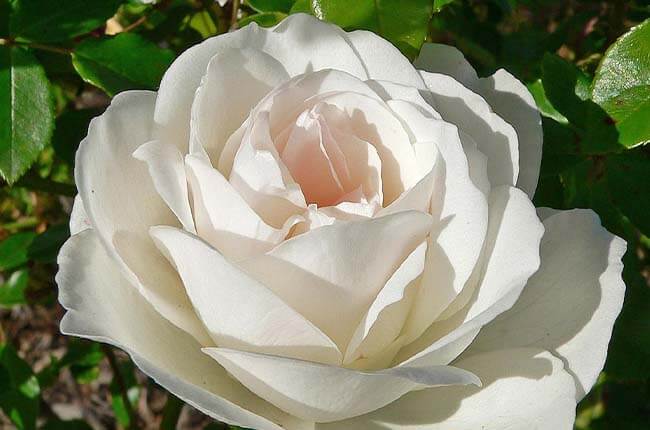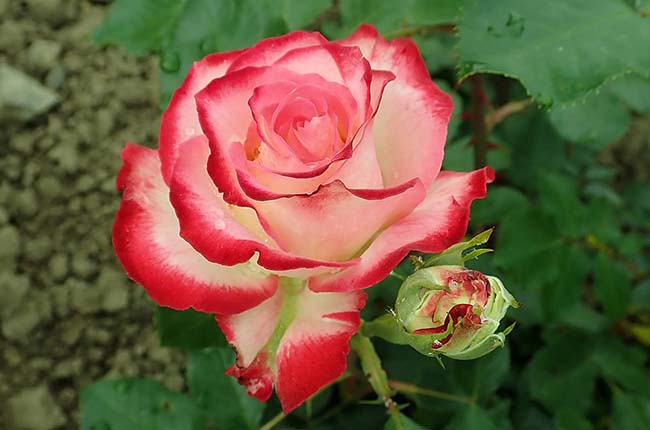The various types of roses can be confusing for anybody, even for rose lovers.
“Tea roses” have single fragrant showy blooms on each long stem, and both the “Grandiflora” and “Floribunda” are more disease-resistant with clusters of flowers on the same stem and longer blooming time.
Apart from that, there are many more differences. Here are 13 differences between the 3 types of roses.
1. Origin
The different types of roses are cross-bred and introduced at different times in history to achieve the best qualities in plant size, flower shape, color, fragrance, and hardiness.
Tea roses are old garden roses that originated in China (Rosa chinensis) over 1000 years. Hybrid tea roses are a cross between hybrid perpetual and tea roses developed for their perfectly shaped flowers and fragrance. They are a standard rose of the floral industry.

(Salicyna, CC BY-SA 4.0, via Wikimedia Commons)
The Floribunda roses are a cross between polyantha roses with hybrid teas. The goal was to create roses that blossom with the more disease-resistant, sprawling extravagance of polyantha yet retain the color diversity, elegance, and sometimes also the fragrance of hybrid teas.
One of the early Floribunda, Rdhaette (‘Red Riding Hood), was developed by Dines Poulsen of Denmark in 1907.
The Grandiflora roses are the newest breeds developed in the 20th century as a cross between Floribundas and hybrid tea roses to produce the biggest blooms while retaining the disease-resistant qualities of the floribundas. The most notable was Rosa ‘Queen Elizabeth,’ which was produced in 1954.
2. Plant shape
Hybrid teas are small, stiff shrubs, usually growing up to 4 or 5 feet (120 – 150 cm).
Floribunda roses are bushier than most hybrid tea roses. They vary from compact to a more open habit growing up to 5 to 6 feet. Floribunda roses give a dramatic visual impact in the garden because their blooms often appear in large sprays.
For example, Cherry Parfait is a floribunda rose with a bushy growth habit and grows to a height of 3 to 4 feet (90-120cm).
Grandiflora roses are the largest in size, growing up to over 6 feet tall. For example, the first Grandiflora rose, the ‘Queen Elizabeth’, is a strong, towering grower that can attain 6 to 7 feet (180 – 210 cm) in height.

(Geolina163, CC BY-SA 4.0, via Wikimedia Commons)
3. Foliage
The foliage of the Floribunda rose is typically glossy chartreuse, whereas that of Tea roses and Grandiflora foliage is blue or green.
Floribunda foliage is typically glossy and green. Rosa ‘Blueberry Hill,’ for example, has glossy dark green foliage that appears early in the season and continues until fall. The foliage of Floribunda Rosa ‘Livin’ Easy’ is also glossy.
Grandiflora leaves are typically dark green. For example, Rosa ‘Earth Song’ is a robust plant with upright growth characteristics and shiny deep green foliage. Grandiflora Rosa ‘Queen Elizabeth’ and Grandiflora Rosa ‘Scarlet Knight’ have deep green foliage on tall, upright plants as well.

4. Bloom size and shape
Hybrid teas are distinguished for their long, straight, and upright stems, with smaller blooms than Grandifloras. Most hybrid tea roses have single blooms.
Floribundas (meaning “many flowers” in Latin) are celebrated for their constant blooming in clusters of blooms on short, thicker stems. Some are single, flat-shaped flowers (with one set of around 5 to 12 petals); others are semi-double (with 2 to 3 times more petals) but most modern hybrids have fully double flowers which are cup-shaped with many more petals.
For example, Rosa ‘Nearly Wild’ has clusters of single pink flowers. Rosa ‘Blueberry Hill’ has semi-double purple blooms. Rosa ‘Iceberg’ has clusters of double white flowers.

(Photo by David J. Stang, CC BY-SA 4.0, via Wikimedia Commons)

(Captain-tucker, CC BY-SA 3.0, via Wikimedia Commons)

(Stan Shebs, CC BY-SA 3.0, via Wikimedia Commons)
Grandifloras are known for their twin blossoms (Varieties of flowers with extra petals). Rosa ‘Octoberfest’ is an example of a semi-double Grandiflora rose.
Similar to Floribundas, Grandifloras flowers are borne in clusters of three to five blooms, on longer, thinner stems and with flatter flowers.
Grandifloras single has about 5-6 petals on average while Floribunda single flowers have about 5-12 petals.
5. Bloom color
All three rose varieties come in a variety of hues, including yellow, white, pink, purple, and even red. There are also dual-color varieties.
Generally, rose tea is found in orange, green, purple, pink, white, red, and yellow.
Usually, Floribunda Rosa comes in pink, blue, white, and red. For example, Cherry Parfait’s petal color is a dual white and red tone.

(Salicyna, CC BY-SA 4.0, via Wikimedia Commons)
Floribunda ‘Julie Kid’ is known as “buttery golden. “The ‘Mardi Gras’ colorful floribunda rose, in contrast, seems to have a festive coloration of pink, orange, and yellow. The flower starts off as an orange blossom and eventually unfolds to show a spectacular 1-to-4-inch pink and orange blossom on a golden foundation.
Typically, Grandiflora Rosa is found in pink, orange, red, purple, yellow, and white. For example, Rosa Grandiflora ‘About Face’ has a lighter shade of deep golden yellow on the inside of the petals and a darker bronzy orange-red on the outside. Some other Grandiflora roses start off reddish-purple or mauve and evolve to a richer color. It certainly not transforms into a genuine blue rose.
6. Flower fragrance
Grandiflora and Floribunda roses have a light to medium fragrance whereas Hybrid Tea roses are known for their strong fragrance.
Popular floribunda roses with good fragrances include:
- ‘Amber Queen’ possesses a strong spicy-sweet fragrance.
- Rosa ‘Angel Face’ has a strong citrusy scent.
- Rosa ‘Blueberry Hill’ flower fragrance is reminiscent of a sweet apple.
- Rosa ‘Cinco de Mayo’ fragrance is like a tart apple.
- Rosa ‘Honey Perfume’ fragrance is like a mixture of honey and spice.
- Rosa ‘Iceberg’ blooms have a light, sweet fragrance.
- Rosa ‘Nearly Wild’ has a light apple scent.
Popular Grandiflora roses with good fragrances include:
- Rosa ‘Honey Dijon’ has a sweet, fruity fragrance.
- Rosa ‘Maria Shriver’ releases a citrus-zest fragrance.
- Rosa ‘Octoberfest’ has a moderate fruity fragrance.
- Rosa ‘Radiant Perfume’ has a citrus scent.
- Rosa ‘Queen Elizabeth’ is lightly scented.
- Rosa ‘Tournament of Roses’ has a light, spicy fragrance.
- Rosa ‘Wild Blue Yonder’ offers a heady fragrance of citrus and tea rose.
7. Blooming time and duration
Floribundas bloom continuously, whereas Hybrid Teas and Grandifloras tend to bloom in 6 to 7-week cycles.
Grandiflora roses typically bloom in late spring or early summer.
Some variants will bloom again in late summer or early fall. As a result, their blossoming season lasts from June to September.
Floribundas bloom throughout the spring and summer, with intermittent blooming in the fall. Some floribunda types have recurrent bloom cycles, which means they will bloom intermittently during the growing season.
A hybrid tea may bloom regularly from spring to October if properly cared for.
8. Thorns
Both Grandifloras and Floribundas have thorny stems, with hybrid teas having mild thorns in its stem.
9. Light requirement
Both the Floribundas plus the Grandifloras tolerate partial shade, whereas it would be much more difficult for tea roses. To survive, plants need a minimum of 7 hours of sunshine per day.
10. Drought tolerance and moisture requirements
Watering is required on a regular basis for Grandifloras, Hybrid Tea roses, and Floribundas with Grandifloras requiring somewhat more moisture than hybrid tea roses and floribundas due to their larger size.
11. Hardiness
Tea Roses and their hybrid species are heat tolerant but not cold tolerant, whereas Floribundas and Grandifloras are much more tolerant to cold.
Floribundas, in particular, are exceptionally hardy and may be grown in the United States Department of Agriculture 4–11 sones. Grandifloras are less hardy and thrive best in zones of 6 to 10. Floribundas tolerate winters and colder regions much better than its counterpart.
As for the tea roses, the original species can grow in a sheltered location protected from extreme weather and winds. The hybrid tea roses are more resilient, but they are still fragile.
12. Disease resistance and care
Floribundas and Grandifloras are disease resistant, while Hybrid Teas are not very disease resistant.
Floribundas are much more tolerant of insects and illnesses than Grandifloras. However, both types of roses are vulnerable to powdery mildew and blackspot, so consistent spraying is required to preserve the roses.
Floribundas do not need a lot of pruning and can sometimes grow on their own without much help. Grandifloras, however, need regular pruning for good ‘single’ blooms. Hybrid tea requires considerable maintenance for it to grow.
13. Uses
Floribundas, Grandifloras, and hybrid teas have quite varied applications. Floribundas are excellent landscape species, and their short, bushy appearance makes them ideal for edgings, mass plantings, and hedges. They are resilient and grow slowly.
Grandifloras, in contrast, grow relatively higher. With the exception of climbers, these are taller than all modern roses. This makes them good for application on screens or on the back side of borders.
The hybrid tea rose produces a brilliant display in any garden with its many, intricate blooms that grow from long stems and reach anywhere from 30 to 50 petals. They are also popular as cut flowers.
Related
Why Rose Cuttings Turn Black (And What To Do)
References
- Top 6 Drip Irrigation Systems for Raised Beds (2025) - January 31, 2025
- Top 10 Orchid Fertilizers: A Comprehensive Review (2025) - January 16, 2025
- Top 6 Slow-Release Fertilizers for Houseplants & Veggies (2025) - January 15, 2025
